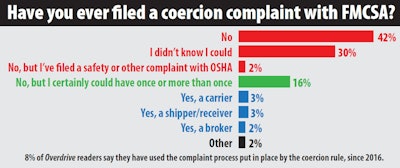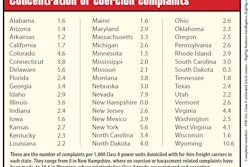Previous piece in this feature package: The irony of e-logging and coercion: Complaints on a steady rise since mandate
 When a dispatcher or other supply chain representative “threatens to withhold work from” or punishes “a driver for refusing to operate in violation” of safety regulations, it can constitute coercion, according to law.
When a dispatcher or other supply chain representative “threatens to withhold work from” or punishes “a driver for refusing to operate in violation” of safety regulations, it can constitute coercion, according to law.A team driver told her carrier of an illness that would prevent her safe operation of the truck. Her codriver was out of hours, so she felt the pair had no choice other than to wait it out. She informed the carrier that driving in her condition would violate 392.3, which prohibits driving while ill or fatigued. She was fired.
This case was under consideration this fall by Minnesota-based Truckers Justice Center attorney Paul Taylor. He’s often involved in cases that result from wrongful-termination complaints to the federal Occupational Safety and Health Administration, under the Surface Transportation Assistance Act, which protects drivers against being fired for refusal to violate a safety regulation. Many of those complaints also end up getting filed with the Federal Motor Carrier Safety Administration as acts of coercion.
While such filings might be straightforward, resolving them is anything but. Evidence is often inconclusive, the process can drag for months, and protection for complainants is impossible if the specific coercive act is what’s ultimately investigated. Add to that list the absence of monetary award to the aggrieved driver, at least under the coercion rule, and possible work disruption for drivers still employed, and there is no shortage of disincentives for blowing the whistle.
 This six-feature package examines outcomes over the four years the FMCSA’s Coercion Rule has been in place. See navigation options at the bottom of the story to examine the remainder of the reporting or follow this link to see a list of the stories.
This six-feature package examines outcomes over the four years the FMCSA’s Coercion Rule has been in place. See navigation options at the bottom of the story to examine the remainder of the reporting or follow this link to see a list of the stories.In creating the rule, FMCSA addressed the identity issue: “Because prosecution of coercion in violation of 390.6 of this subchapter will require disclosure of the driver’s identity, the Agency shall take every practical means within its authority to ensure that the driver is not subject to harassment, intimidation, disciplinary action, discrimination, or financial loss as a result of such disclosure,” the rule states.
Part of those “practical means” FMCSA can employ includes emphasis to any investigated carrier of the protections granted under STAA against retaliatory action. In conducting investigations in response to complaints, too, FMCSA can withhold the complainants’ identity by focusing not on coercion itself but on the underlying violations.
Whistleblower complaints about carrier safety or retaliatory action made to OSHA, too, come with a measure of identity protection by law not found when it comes to coercion complaints.
In the team drivers’ case Taylor outlined, the coercive act is clear not only because the retaliatory threat was acted upon, but also because the driver clearly informed the carrier that her driving would violate the regulations. The women in that case told Taylor their coercion complaint, filed weeks earlier, “hasn’t had a result,” he says. Full investigations of such cases can take months.
 Read more about coercion complaints against entities other than carriers, including shippers and brokers, via this link.
Read more about coercion complaints against entities other than carriers, including shippers and brokers, via this link.Another case was aired during a conference call in September in which Bill Mahorney, FMCSA’s Enforcement Division chief, and the Commercial Vehicle Safety Alliance’s Chris Turner (formerly of the Kansas Highway Patrol) heard testimony from drivers and safety personnel at a fleet with about 150 drivers. The call was organized by Vince Crisanti of the Trucking Solutions Group, a group of owner-operators who meet regularly to share business ideas.
A young driver, going by “Charlie Brown” on the call, recalled starting one day with a brief run to return to the company’s terminal. “They told me I was due out on a run that night 10 hours later,” meaning it was unlikely he’d get the necessary rest midday to make the overnight run safely.
When Brown later told management he was too fatigued to handle the run, rather than being sent home, the company invoked a policy in which a driver too ill or fatigued to drive is required to report to the yard for an eight-hour on-site shift at the time of the dispatch.
Management found him catnapping in a parked truck during the late-night shift and he was sent home. After receiving no dispatch for the next two weeks, he resigned. He learned a month later that, in the company’s view, he had been terminated, further compounding the ramifications for him.
Mahorney, pointing to 49 CFR 392.3, which covers ill and fatigued driving, said Brown followed the proper procedure by telling the carrier he was too fatigued to operate safely. “If the company doesn’t accept that, that could be a coercion complaint,” Mahorney says.
While CVSA’s Turner expressed skepticism that this incident constituted coercion, an STAA case could be made, he said, given the punitive actions taken. “Use the other remedies that are available to you.”
At once, if FMCSA doesn’t hear about such instances of punitive policies, they can do little to correct them, Mahorney and others on the call stressed. Turner and Mahorney also emphasized roles for state enforcement, including roadside inspectors, to act upon such apparent problems.
Turner said when he was the lead highway patrol contact in Kansas for the Motor Carrier Safety Assistance Program (MCSAP) lead agency, a driver in a coerced circumstance would occasionally call in a violation from the road. To protect the driver from retaliation, Turner said, “We’d perform stops on this driver, and we’d put it on our inspection report as a random stop, and the carrier would never know it was going on.”
Such tactics by drivers could have double-edged consequences. The carrier cited for an underlying violation would get dinged, but so would the driver, with the violation carrying through to his/her Pre-Employment Screening Program record for three years. Yet the violation could bolster the driver’s case in working behind the scenes with law enforcement to encourage better behavior at the fleet.
Also, Turner noted, if you’ve taken your complaint to a state division of the highway patrol or an individual patrolman or inspector and it seems like nothing is happening, appeal to the lead agency for MCSAP in the state, Turner says. “Be sure to talk to your MCSAP commander or someone in charge of the commercial vehicle enforcement unit.” (Find a list of MCSAP leads in every state via CVSA.org/contactpage/contacts. Click “Law Enforcement Lead Agency Contacts.”)
The picture presented of the fleet on the conference call was one summed up well by owner-operator Crisanti: “Coercion is not necessarily a two-by-four in the face. Rather, it’s many, many splinters.”
Read next: Parties other than carriers now subject to enforcement under the coercion rule
Also in this package:
Cracks in the system: Blowing the whistle on coercion
The irony of e-logging and coercion: Complaints on a steady rise since mandate











